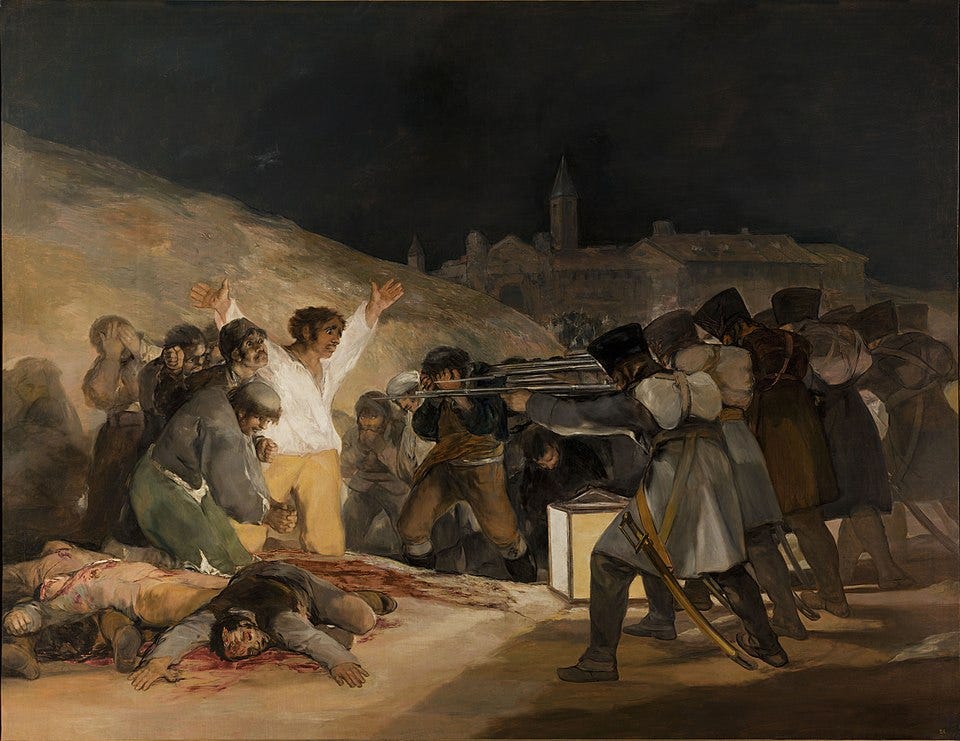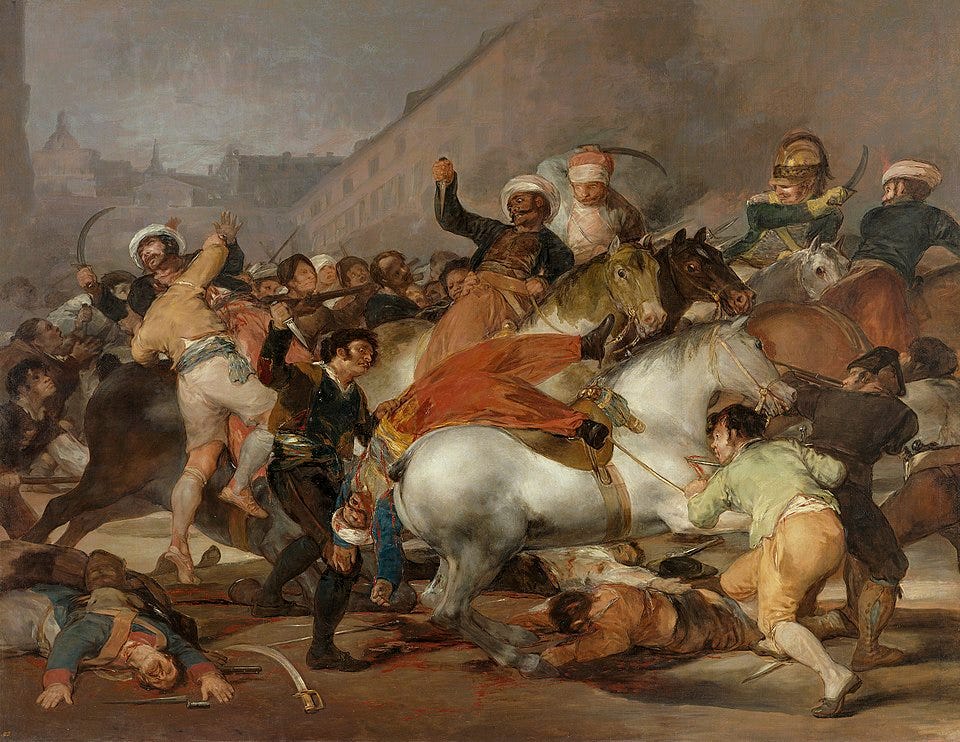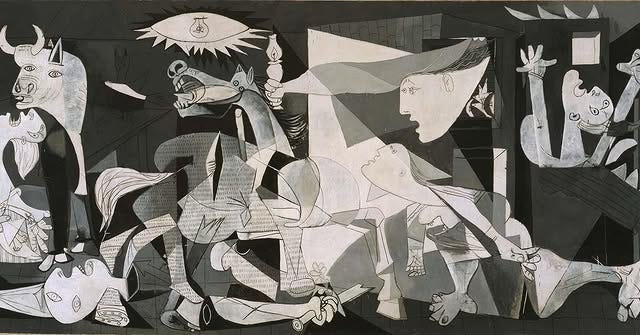Francisco Goya’s The Third of May 1808, painted in 1814, stands as one of the most powerful anti-war statements in the history of art.

Commissioned by the provisional Spanish government following the expulsion of Napoleon’s troops, the painting commemorates the brutal execution of Spanish rebels by French forces. However, Goya’s work transcends mere historical documentation. Through dramatic composition, vivid symbolism, and emotional intensity, The Third of May becomes a universal indictment of violence and the dehumanising effects of war.
To fully understand The Third of May, we must also look at Goya’s preceding painting depicting the night of May 2, 1808, when Spanish citizens first rose up against French occupiers in Madrid.

The Second of May 1808 (1814) depicts a brutal, chaotic street battle between Spanish insurgents and French soldiers. It shows the fierce struggle of the people of Madrid defending their city and highlights the energy and desperation of the resistance.
The Third of May 1808 in turn captures the retaliation for the May 2 uprising when the French executed hundreds of suspected rebels the following day. Goya's depiction of this massacre focuses not on a heroic battle but on a tragic moment of despair and moral outrage.
Painted within two months of each other, The Second of May 1808 captures the explosive violence of the conflict, while The Third of May focuses on the aftermath, the crushing sorrow and hopelessness in the face of defeat.
Both paintings were completed in 1814 and are currently housed in the Museo del Prado, Madrid. Together, these works form a powerful visual record of Spain's suffering during the French occupation, illustrating the human cost of war and the brutality of oppression.
What makes Goya’s The Third of May so powerful is largely due to the arrangement of compositional elements that evoke key emotional and symbolic messages. At the heart of the painting stands a lone Spanish man, arms flung wide in a pose reminiscent of Christ on the cross. Illuminated by a harsh lantern, his white shirt glows against the surrounding darkness, casting him as both martyr and everyman. His expression is a blend of horror, defiance, and disbelief.
Around him lie the bloodied bodies of others already executed, while to his side, a line of French soldiers, faceless and mechanical, aim their rifles with cold precision. This chilling contrast between the individuality of the victims and the anonymity of the executioners is one of Goya’s most potent artistic strategies.
Stylistically, Goya breaks the neoclassical norms of his time, favouring raw emotion over idealised beauty and his use of light is particularly striking. While traditional paintings used light to highlight divinity or clarity, Goya uses it to emphasise horror. The lantern in the centre does not illuminate truth or hope; instead, it exposes the brutality of the scene in stark, unforgiving detail. The background is nearly black, devoid of scenery, reducing the world to a stage for senseless slaughter.
Symbolism runs deep in The Third of May. The man in white can be interpreted as a symbol of innocence, sacrifice, or even the Spanish nation itself. His crucifix-like stance, dimpled hand, and expression of agony all recall religious imagery, suggesting a spiritual dimension to the suffering. Meanwhile, the French soldiers are portrayed not as individuals but as faceless machines of war.
Goya is not interested in demonising a particular nationality; rather, he condemns the very nature of institutional violence, showing how ordinary people become instruments of death when ideology overrides empathy.
Unlike earlier depictions of war, which often glorified heroism and courage, Goya offers no comfort, no redemption. Goya himself lived through the brutal realities of the Peninsular War and would have been acutely aware of the atrocities surrounding him. His personal experiences undoubtedly shaped his perspective on the human cost of conflict. The visceral power of The Third of May reflects not only his intellectual engagement with the events of the time but also his deep emotional response to the suffering he witnessed.
There are no victors in The Third of May, only victims. This humanistic approach marks a turning point in artistic representations of conflict. Goya’s work reflects a profound disillusionment with the capacity of humanity for cruelty. In doing so, he laid the groundwork for future artworks, like Otto Dix’s war etchings (1923-24) or Picasso’s Guernica (1937), that similarly confront the horrors of modern warfare head on.
Goya’s The Third of May 1808 continues to resonate in contemporary contexts, serving as a reminder of the cost of war and the importance of bearing witness. Its emotional immediacy speaks across cultures and centuries, evoking empathy and outrage in equal measure.
In a world still plagued by violence and injustice, Goya’s painting remains fiercely relevant. The Third of May 1808 is a visual cry for compassion, accountability, and peace. Through Goya’s innovative use of composition, light, and symbolism, he forces viewers to confront the darkest corners of human behaviour. The painting stands as a testament to the power of art not just to depict events, but to question them, mourn them, and ultimately, to awaken a shared sense of humanity.







Thank you for this post.
“… when ideology overrides empathy”, sadly, this is timeless and a timely reminder.
Could art such as Goya’s be a more universal reminder of the necessity of democracy over oppression?
Perhaps visual art is a way beyond the mire of misinformation.
"when ideology overrides empathy"... I will remember these words.
Goya's print "The Sleep of Reason Produces Monsters" is also very much relevant to our times.